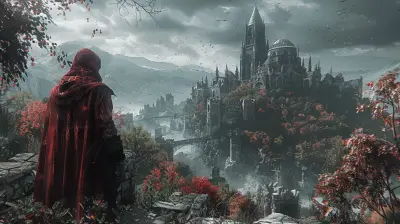Trending Game Engines Developers Are Switching To
1 November 2025
Gaming is evolving at a blistering pace. What used to take months or even years to prototype and build can now be done in weeks thanks to powerful new game development tools. And at the center of that transformation? Game engines. Yeah, those behind-the-scenes, code-heavy beasts are becoming more intuitive, flexible, and downright impressive!
But here's the thing—developers are making some big moves. They're shifting away from the "old reliable" engines and turning to newer, trendier, and more customizable platforms. So if you’re a developer, aspiring indie dev, or just a curious gamer wanting to know what’s under the hood of your favorite titles, this is for you.
Let’s dive into the trending game engines developers are switching to—and why you should care.
Why Are Developers Switching Game Engines?
Before we get into the nitty-gritty, here's a simple question: why would someone switch game engines mid-career (or even mid-project)? That’s like trading your favorite comfy sneakers for something new—you’ve gotta have a good reason, right?Here are a few reasons devs are making the change:
- Flexibility & Freedom: Some engines allow more creative control.
- Licensing Costs: With pricing models changing, devs are watching their wallets.
- Performance & Capabilities: New engines can handle cutting-edge tech better.
- Open Source Options: Developers love tinkering. Open source = heaven.
- User Community: Bigger, more helpful communities make life easier.
Alright, now that we’ve got the why, let’s talk about the who.
1. Godot Engine — The Indie Favorite
If game engines were musicians, Godot would be the indie rockstar building a cult following.Why Godot?
Godot is completely free and open source. No licensing fees. No revenue caps. No nonsense. It’s the freedom fighter of the game dev world. And it’s especially loved by indie developers who want full control over their game, from visuals to scripting.Key Features:
- Open Source: Modify anything, anytime.- Scene System: Makes it super easy to build game logic hierarchically.
- GDScript: Custom script language like Python—easy to learn and use.
- Multi-Platform Deployment: PC, mobile, web—you name it.
- 2D & 3D Support: Great for stylized 2D games, with improving 3D capabilities.
What’s New?
Godot 4.0 brought Vulkan support, making it way more powerful for 3D games. Now we’re seeing even some mid-tier studios experimenting with Godot for new titles. It’s becoming a legit competitor, and that’s saying something.
2. Unreal Engine 5 — The Powerhouse Reinvented
Let’s not beat around the bush—Unreal Engine 5 is a beast. Epic Games has outdone themselves.Why UE5?
If you want high-fidelity, photorealistic graphics and next-gen performance, Unreal is hands-down one of the most powerful tools out there. And with UE5, it's more friendly than ever—even for beginners.Key Features:
- Nanite: Virtualized micro-polygon geometry—crazy detail, less performance cost.- Lumen: Real-time global illumination and reflections. Say goodbye to light baking!
- MetaHuman: Instantly create realistic human models.
- Blueprint System: Visual scripting for non-coders.
Why Developers Are Switching
UE5 delivers AAA visuals without needing a AAA team. Smaller studios are now using it to deliver stunning visuals rivaling big-budget games. Plus, Epic’s generous revenue-sharing model (you pay after your game makes $1M) is a win for many.
3. Unity — Reinventing Itself (Again)
Unity has been around forever and is still widely used—but it’s been a bit of a rollercoaster lately.Why Some Developers Are Leaving?
Between controversial pricing model changes and stagnating updates, Unity has lost some goodwill with indie devs. Some are jumping ship to Godot or Unreal. But let’s not forget—Unity still powers a gigantic chunk of mobile and 2D/3D games.Why Others Are Staying?
Unity is accessible, has a massive asset store, and supports everything from mobile to AR/VR. If you’re building cross-platform games quickly, Unity still gets the job done.Key Features:
- CScripting
: Straightforward programming language.- Asset Store: Ready-made assets and plugins galore.- Flexible Rendering Pipelines: HDRP and URP support.
- Cross-Platform Deployment: Over 25 platforms supported.
The Verdict?
Unity’s still in the game, but it's got competition breathing down its neck. The next couple of years will be critical.4. Amazon Lumberyard / Open 3D Engine — The Dark Horse
Remember CryEngine? It gave us games like Crysis that made PCs sweat. Amazon essentially adopted CryEngine and created Lumberyard. Now, the Open 3D Engine (O3DE) has emerged as a serious contender.What’s the Big Deal?
O3DE is open source and community-driven. It’s backed by the Linux Foundation and has contributions from companies like Adobe, Intel, and AWS. This engine is built for high-quality, large-scale games.Key Features:
- Based on CryEngine: So you know it can crank out great visuals.- Modular Architecture: Customize everything with ease.
- Cloud-Ready: Integrated with AWS for cloud-based multiplayer gaming.
- VR/AR Capabilities: Built with spatial computing in mind.
Who’s Using It?
Right now, it's geared more toward studios with ambitious projects who want full control and scalability—not really plug-and-play like Unity or Godot. But its potential is massive.5. Cocos Creator — The Mobile King
Cocos has quietly become the king of mobile game engines, especially in Asian markets.Why Cocos?
It’s lightweight, optimized for mobile, and free. Cocos Creator, the latest tool from the Cocos engine family, offers a modern interface and workflow that rivals that of Unity—without the hefty licensing strings.Key Features:
- JavaScript/TypeScript Support: Perfect for web and mobile devs.- Small Package Size: Critical for mobile game performance.
- Built-in UI Tools: Super handy for casual games and RPGs.
- Cross-Platform: iOS, Android, web, and more.
The Catch?
It’s mostly targeted at mobile and casual game developers. Less suited for big 3D titles, but if your niche is mobile, this engine is gold.6. CryEngine — Making a Quiet Comeback
CryEngine has been the quiet genius in the background. Known for jaw-dropping graphics and open-world capabilities, it's not as mainstream as Unreal or Unity, but it's still kicking.Key Features:
- High-End Visuals: Real-time lighting, volumetric effects, etc.- Real Physics Engine: Great for destructible environments.
- Sandbox Editor: Real-time editing and tweaking.
- VR Support: Robust features for immersive experiences.
Why the Comeback?
Recent updates and licensing changes are making developers look twice. CryEngine is still complex and has a steep learning curve, but it’s got a niche appeal for visually intensive experiences.7. Stride (formerly Xenko) — The Hidden Gem
Heard of Stride? Probably not. But the devs who use it love it.Why Stride?
It’s an open-source Cengine with full 3D support. Think of it as a blend between Unity’s scripting and Unreal’s visuals—but made by the community, for the community.
Key Features:
- CSupport
: Great for .NET developers.- Visual Editor: User-friendly and highly customizable.- Real-Time Editing: What you see is what you get.
- VR/AR Friendly: Emerging as a solid AR/VR development tool.
It’s not for everyone, but it’s growing fast thanks to its open architecture and dev-friendly ecosystem.
So, Which Engine Should YOU Choose?
Let’s be real—there’s no one-size-fits-all answer. Choosing a game engine depends on what you’re making, your team size, and your experience level.Here’s a bite-sized rundown:
| Engine | Best For | Learning Curve | Licensing |
|----------------|------------------------------|----------------|------------|
| Godot | Indie 2D/3D Games | Easy | Free/Open |
| Unreal Engine | AAA Graphics, Realism | Moderate | Free (Until $1M) |
| Unity | Mobile, Prototyping, 2D/3D | Easy to Medium | Free/Pro Options |
| O3DE | Large Scale, Custom Projects | Advanced | Free/Open |
| Cocos Creator | Mobile Games | Easy | Free |
| CryEngine | Realistic Visuals, Open World| Advanced | Free |
| Stride | Cross-Platform, Dev Tweaks | Medium | Free/Open |
Ask yourself: What kind of player experience am I aiming for? How much control do I want? And what coding languages am I comfy with?
Because the right game engine isn't just a tool—it’s your creative home base.
Final Thoughts: The Engine (R)evolution
Game engines are no longer just a means to an end—they're a playground where imagination meets execution. As tech pushes boundaries, so do the tools. Developers are getting pickier about what they use, and rightfully so.Whether you're a hobbyist cooking up the next pixel-art platformer or part of a squad gearing up for a next-gen shooter, there's a game engine out there tailored for your dream.
So, what’s it gonna be? Are you sticking with the classics or jumping on the new wave?
all images in this post were generated using AI tools
Category:
Game NewsAuthor:

Lucy Ross
Discussion
rate this article
1 comments
Loretta Pruitt
Great insights! It's fascinating to see how developers are adapting to new game engines. I appreciate the effort to highlight these trends, as it really helps those of us wanting to stay updated in the gaming industry. Thank you!
November 6, 2025 at 5:06 AM


